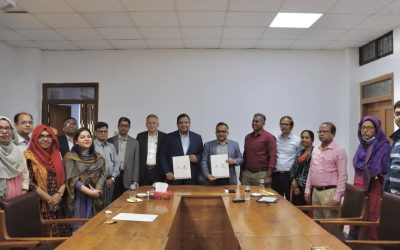InAsia
Insights and Analysis
How “Digital Public Goods” Are Transforming India’s Healthcare System
June 14, 2023

A Project coordinator for India’s Aayushman Bharat Digital Mission demonstrates how patients can scan a QR code to register and share their health details digitally without filling out any forms. This has reduced the wait time at government health facilities. (Photo: Puja Negi / The Asia Foundation)
As India emerged from the trials of the pandemic lockdown, a small mosaic of black and white lines and squares began to appear: on paper cards atop vegetable carts in local markets, on stickers in automobiles and tuk-tuks, dangling from the IDs of gig workers delivering food, medicines, and groceries, and shared in mobile messaging apps among friends. The now-ubiquitous QR or Quick Response code has simplified payments for over a billion people. The online payment system has eased everyday transactions, especially for informal workers and small and medium businesses. But beyond the cashless economy, QR code technology is finding a home in other industries, including the healthcare sector.
In a once-unimaginable development, most payments in India can now take place in a cloud-based ecosystem called India Stack, a public digital platform that enables “presence-less, paperless, and cashless service delivery,” with social and financial benefits to citizens across the country. Originally developed to provide a unique, national ID to connect welfare recipients to their bank accounts, India Stack, through a series of cascading innovations, now supports customized digital healthcare solutions such as nationwide management of patient records, verification of healthcare providers, and access to care.
Unpacking India’s telemedicine journey
The pandemic serendipitously triggered the expansion of cloud-based healthcare solutions in India. Digital access to telehealth and telemedicine services grew exponentially as citizens turned to remote healthcare and counseling and booked vaccination appointments online. This evolution in augmenting and coordinating healthcare services during a public health emergency demonstrates the potential for digital technologies to strengthen healthcare systems and make them resilient in emergencies and disasters.
The term “telemedicine,” for medical care at a distance, first emerged in 1970, in the era of the television and the telephone. Telemedicine today, using digital technologies, can collect and share a vast array of information to provide specialized medical functions such as telediagnosis, tele-surgery, and teleradiology.
Telemedicine in India began as a pilot project of the Indian Space Research Organization in 2001, in partnership with a private-sector hospital. In 2015, the Indian government launched the Social Endeavour for Health and Telemedicine, connecting 60,000 Common Service Centers (CSCs) that provide village access points to a wide range of digital services. Through this initiative, the CSCs partnered with private-sector service providers such as Apollo, Medanta, Hello Health, Forus Health Private Limited, and Thyrocare to improve their capabilities.

An e-health and wellness center under India’s Ayushman Bharat Digital Mission that offers a range of primary healthcare services using the eSanjeevani telemedicine platform (Photo: Puja Negi / The Asia Foundation)
During the multiple waves of the pandemic that began in March 2020, India launched the Telemedicine Practice Guidelines manual, which covered both general and traditional medicine. The manual provides information on norms and protocols for the patient-physician relationship, including continuity of care, privacy and security of patient records and data, guidelines for prescribing medication, and health education and counseling. In addition to the guidelines, Covid-19 National Teleconsultation Centers connecting all Indian states to the All-India Institute of Medical Sciences were created for real-time consultations.
Building Lego-like on the India Stack architecture, the eSanjeevani telemedicine platform is a flagship national digital healthcare solution. The vision of the platform is to provide every Indian citizen remote access to quality healthcare, facilitated by a unique patient ID that can be shared securely among many different healthcare providers.
From a pilot public-private partnership, the eSanjeevani platform has evolved to become one of 15 “digital global goods” of the Indiastack.global ecosystem. Organized as a hub-and spoke design, the telemedicine network supports web-based teleconsultation services, including online patient registration, video-based clinical consultations between doctors in hospitals and patients at home, e-prescriptions, and e-mail follow-up services. All these services are available at no cost through smartphones or by visiting a Health and Wellness Center. Other telehealth pilot projects in India include the Hospital Management Information System, which offers a unique dashboard for citizens to interact with healthcare providers across India; the Yoga Center Locator application; and the AyushQure traditional medicine app, for expert teleconsultation and links to dispensaries.

A doctor at a primary health center consults a specialist virtually through the eSanjeevani telemedicine platform. (Photo: Puja Negi / The Asia Foundation)
How can telemedicine expand healthcare service delivery?
While the use of telemedicine in India is relatively new, it has promising applications for wider healthcare delivery in other countries with healthcare needs and infrastructure similar to India’s. The Asia Foundation’s work on India-U.S. triangular development cooperation during disasters has highlighted potential applications for telemedicine in countries in the Indo-Pacific. India’s experience of telemedicine during the pandemic demonstrated tested, tweakable, and transferable telehealth solutions that support access, continuity of care, and a coordinated pooling of public health resources for better healthcare services during emergencies.
Our previous analysis and conversations with stakeholders from these countries showed that there is a demand for digital healthcare solutions during public health emergencies and for psychosocial care in the immediate aftermath. These solutions hold promise for other countries to pilot, adapt, and scale healthcare delivery applications for times of crisis or disaster and to enable general medical care for hard-to-reach populations.
Digital healthcare in India now offers both an online library and a marketplace for the nearest verified doctor, lab, pharmacy, and hospital. These details are maintained in electronic patient records secured by unique IDs, along with verified online registers of providers, facilities, and drugs available in the market. The exchange of patient records among entities in the marketplace is governed by patient consent secured by a one-time password or QR code. Over time, a secure record of their medical history is accurately recorded for every registered citizen.
As climate change and unpredictable weather events contribute to public health emergencies such as heatwaves and increase the incidence of water- and vector-borne diseases, healthcare systems need a resilient information architecture to ensure their reliability. Other challenges include data privacy, interoperability, and the difficulty of serving vulnerable communities who may face a digital divide. And there is always the human element: buy-in and training of healthcare personnel, completing the transition to digital from paper forms, and establishing uniform standards of care.
The eSanjeevani platform, with its large and extensible operating ecosystem, is a successful and replicable solution. Its evolution is the story of how India, a vast and diverse country, has pioneered digital healthcare platforms, and it demonstrates possibilities that other countries can learn from and adapt.
Malavika Thirukode is a program officer and Ajay Kumar Singh is the former monitoring, evaluation, learning, and adaptation specialist with The Asia Foundation’s India-U.S. Triangular Development Partnership program in India. Malavika can be reached at [email protected]. The views and opinions expressed here are those of the authors, not those of The Asia Foundation.
About our blog, InAsia
InAsia is posted and distributed every other Wednesday evening, Pacific Time. If you have any questions, please send an email to [email protected].
Contact
For questions about InAsia, or for our cross-post and re-use policy, please send an email to [email protected].The Asia Foundation
465 California St., 9th Floor
San Francisco, CA 94104
The Latest Across Asia
Media Coverage
May 15, 2024
Program Snapshot
May 15, 2024
Program Snapshot
May 2, 2024

2024 Lotus Leadership Awards
The Lotus Leadership Awards recognize contributions towards gender equality in Asia and the Pacific







0 Comments